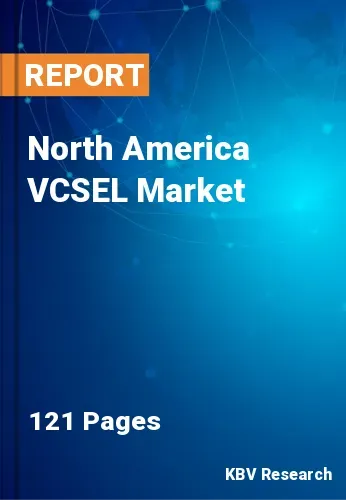The North America VCSEL Market would witness market growth of 12.3% CAGR during the forecast period (2022-2028).
In contrast to edge-emitting semiconductor lasers, VCSELs can be examined and described immediately after growth, i.e., before the wafer is cleaved, which is a significant practical advantage. This allows for early identification and fast resolution of quality issues. In addition, it is feasible to merge a VCSEL wafer with an array of optical elements (such as collimation lenses) and then dice this composite wafer instead of installing the visual elements separately for each VCSEL. This allows for inexpensive laser product mass manufacture. Compared to the creation of edge-emitting lasers, creating VCSELs has several advantages.
Edge emitters can only be checked once the production process is complete. Production time and processing materials are well-spent if the edge emitter operates properly due to faulty contacts or poor material growth quality. However, VCSELs can be evaluated at multiple stages throughout the manufacturing process to check for material quality and manufacturing defects. For example, suppose the vias, the electrical connections between circuit layers, were not fully cleared of dielectric material during the etch. In that case, an interim testing process will indicate that the top metal layer is not establishing contact with the initial metal layer.
The Canadian automotive industry is amongst the largest in North America. Imports account for around 75 percent of the new vehicle market. Most international vehicle manufacturers are in Canada, with their local assembly lines. In addition to recent vehicle sales, the industry predicted in 2021 that the annual retail value of the automotive aftermarket was over US$19 billion and generally stable. Passenger vehicle imports increased by nearly 26% to $27.8 billion in 2021. Also, the imports of trucks and other goods-transporting vehicles, as well as tractors, increased. This will boost the market's growth in the region.
The US market dominated the North America VCSEL Market by Country in 2021, and would continue to be a dominant market till 2028; thereby, achieving a market value of $588.9 million by 2028. The Canada market is poised to grow at a CAGR of 14.9% during (2022 - 2028). Additionally, The Mexico market would witness a CAGR of 13.9% during (2022 - 2028).
Based on Type, the market is segmented into Multimode and Single mode. Based on Wavelength, the market is segmented into Near Infrared (NIR), Shortwave Infrared (SWIR) and Red. Based on Application, the market is segmented into Sensing, Data Communication, Industrial Heating & Laser Printing and Others. Based on Data Rate, the market is segmented into 10.1 to 25 Gbps, Up to 10 Gbps and Above 25 Gbps. Based on Material, the market is segmented into Gallium Arsenide (GaAs) and Indium Phosphide (InP) & Others. Based on Industry, the market is segmented into Consumer Electronics, Data Center, Commercial & Industrial, Automotive, Healthcare and Military. Based on countries, the market is segmented into U.S., Mexico, Canada, and Rest of North America.
Free Valuable Insights: The Global VCSEL Market is Estimated to reach $2.7 Billion by 2028, at a CAGR of 13.1%
The market research report covers the analysis of key stake holders of the market. Key companies profiled in the report include II-VI, Incorporated, Lumentum Holdings, Inc., ams-OSRAM AG, Broadcom, Inc., Leonardo SpA, MKS Instruments, Inc., TRUMPF GmbH + Co. KG, Santec Corporation, Vertilite Co., Ltd., and TT electronics PLC.
By Type
By Wavelength
By Application
By Data Rate
By Material
By Country

Our team of dedicated experts can provide you with attractive expansion opportunities for your business.

